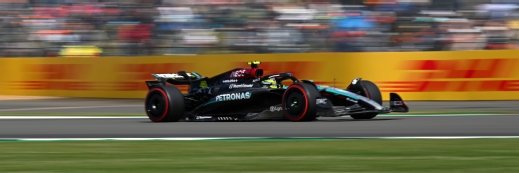
Mercedes-Benz AG
CIO interview: Michael Taylor, Mercedes-AMG Petronas Formula One
We speak to the IT director of the Mercedes-AMG Petronas Formula One team about historical data, race data and fast-paced analytics
Michael Taylor, IT director of the Mercedes-AMG Petronas Formula One team, has been involved in the IT behind Formula One for more than 20 years.
During that time, he says the biggest change is that instrumentation and data analytics has now expanded across every aspect of the organisation.
For instance, the vehicle dynamics group at Mercedes F1 is developing what Taylor describes as “a kind of virtual modelling”. He says: “We are trying to get as close to a digital twin of the car as possible, but it is very, very difficult to do because the car is constantly evolving.”
GPS data of the cars, and those of competitors, is also available to the team. The racetrack is constantly evolving, says Taylor. “The cars go round laying rubber,” he says. “When the race finishes on Sunday, we’ll have a combination of both simulation data leading up to the event and also the real-time data that is captured during the race.”
Taylor began his IT career in local government, but took an opportunity to join Formula One. He says: “I left the far healthier IT infrastructure in local government where I used to take care of systems such as those for council tax payments and went to Renault [the car maker that took over the Benetton Formula One team in 2000]. To be honest, it was quite an eye-opener for me.”
At the time, Benetton was sponsored by Novell, and through connections in a boutique Novell consultancy in the UK, Taylor was put forward for a job in the Formula One team.

“There’s lots of gut feeling. Data is often used as a reference to back that up.”
Michael Taylor, Mercedes-AMG Petronas Formula One
He eventually joined in 2002. “That was the start of my Formula One career,” he says. “I must admit, I only planned a couple of years. I wasn’t really sure about it. I liked to watch the sport, but I was never a massive fan.”
As he recalls, at the time there was an explosion of data, which led to teams “pushing the envelope of the regulations and what was and wasn’t acceptable. I think as the FIA [motor sport’s governing body] and the sport realised, there was a need to standardise.”
But data has always been around in Formula One. “If we go all the way back to the 50s, we didn’t have ECUs generating and logging vast amounts of data – but we had a stopwatch,” says Taylor.
The performances of the racing cars of the day were timed lap after lap. Even today, when data is everything in the sport of Formula One, Taylor says: “The stopwatch is the only true metric of the effective performance of your organisation these days. The stopwatch never lies. Ultimately, all we are chasing in this sport is an improvement in the time it takes for the car to go around the track. Now, there are lots of varying tracks, lots of different cars, but that’s ultimately what it’s all about.”
Data drives car performance
Setup of the cars involves a significant amount of driver input, together with a load of engineering input. This, says Taylor, is both data-led and instinct-led. “There’s lots of experience, lots of instinct,” he says. “There’s lots of gut feeling. Data is often used as a reference to back that up, or to correlate.”
On the Monday after a race, the team go about building the next iteration of the theoretical digital twin, which evolved over the course of the weekend. “It’s then about trying to play catch-up with the virtual model to make sure it is representative of what happened during the race weekend,” he says.
While it would seem the fast-paced world of Formula One involves a highly iterative development lifecycle, Taylor says: “These days, there is always an assessment of benefit and value between waiting to pull together a number of different updates into a single package or bringing in those individual updates as quickly as they are available.”
Read more CIO interviews
- As the IT handover from Asda to Walmart looms, Asda CIO Carl Dawson explains how the business is renewing all of its technology, putting the retailer in the rare position of being able to start from scratch.
- As organisations put more and more IT assets into the cloud, it makes more sense to manage networks cloud natively, says Warner Music CIO.
During the race weekend, says Taylor, “we’ve got engineers in place who are under severe time pressures – they have an abundance of data that they need to sift through very quickly to make decisions”.
The team is using Tibco Spotfire to visualise data, in order to show anomalies or outline data and present this to the engineers responsible for aerodynamics, vehicle dynamics and race strategy.
With the car evolving rapidly over the course of a season and during each race, the team collects vast quantities of historical data. Taylor says one of the challenges is that it is not practical to retain all this data. However, historical data is important from a learning perspective. “If we could use it effectively, we know there’s huge amounts of potential value from all of the logged historical data,” he says.
Even with changes in regulations and the constant evolution of the car, at the most empirical level, Taylor says: “There’s lots of correlation between events. In Formula One, you always have an acceleration event, a braking event or a turning event. And a lap is broken down into three sectors. These events still offer valid learnings as the same events occur across a range of seasons and across a range of cars and drivers.”
What this means is that the first place that race engineers drill into as a reference for the next circuit is the trove of historical data.
True digital twin
Looking to the future, among the areas Taylor would like to evolve is the ability to overlay this historical data within a real-time model of the race car – a true digital twin. “You would then know what the outcome is going to be,” he says.
Such a model could use predictive analytics to predict how the race will play out, he says. According to Taylor, this model could help race engineers, the drivers and the team to understand why an event happens. For instance, such analytics would enable the team to predict that there will be an overtaking event in two and a bit laps and understand all the reasons why it will occur.
“We’re not quite there yet,” says Taylor. “But we’re certainly working in that direction.”
Beyond using data to improve the car’s performance, Taylor says the impact of the financial regulations on Formula One means teams need to be much more aware of costs these days. “During 2020 in preparation for the 2021 regulations landing, we worked closely with Tibco to develop a tool that effectively would give us greater visibility,” he says.
The tool allows Mercedes-AMG Petronas to gain visibility and insight into the cost impact of the development direction that the race car needs to take.









